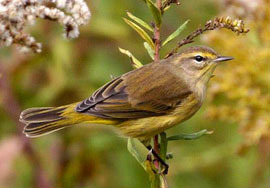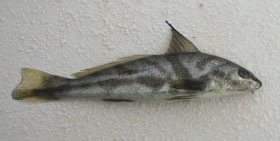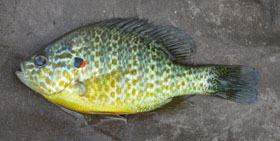Hudson River Almanac 10/8/16 -10/14/16
The New York State Department of Environmental Conservation sent this bulletin on 10/21/2016 04:21 PM EDT |
| DEC Delivers - Information to keep you connected and informed from the NYS Department of Environmental Conservation |
| Share or view as a web page || Update preferences or unsubscribe |
|
|
|
OVERVIEW In a week of highlights, the documentation of a rare albino vulture certainly seemed the best. An old record at the New York State Museum, forgotten until now, provided a new fish species, number 226, for the Hudson River watershed list. HIGHLIGHT OF THE WEEK 10/10 - Ulster County, HRM 72: Twice I spotted what looked like an albino turkey vulture flying around with other vultures and wondered what it was until they all landed and I could see it in the company of the other birds. It was an albino vulture. Later it left with the flock and headed toward Tillson Lake. I have many vultures here in what Heinz Meng once described as an “established roost that may be decades old.”
NATURAL HISTORY NOTES 10/8 – Kowawese, HRM 59: My SUNY-ESF Fisheries Science Practicum class made ten hauls with their 50-foot seine early this morning. While we caught pretty much the fish we expected, an unexpected surprise were ten young-of-the-year (YOY) American shad. They were good sized – mean total length was 94.3 millimeters [mm] – and looked nice and healthy. Among other YOY fishes were schools of Atlantic menhaden and numerous striped bass (mean total length 81.0 mm). The water was 68 degrees Fahrenheit and the salinity was 2.5 parts-per-thousand [ppt]. 10/08 – Croton-on-Hudson, HRM 35: I spotted five osprey over the bay along the north side of Croton Point. Their migration was stalled and for good reason: Their focus was on the menhaden-rich waters of Haverstraw Bay. I watched as at least one of them flew past carrying a bunker. [Atlantic menhaden are a species of herring that spawn in salt to brackish water. Adults, also known regionally as bunker, mossbunker or pogies, and their young-of-the-year, also known colloquially as peanut bunker or penny bunker, are found by the millions in the estuary in summer and fall, providing forage for striped bass, bluefish, osprey, harriers, eagles and seals. Tom Lake.] 10/8 – Bedford, HRM 35: 10:30 - A golden eagle was spotted this morning at the Chestnut Ridge Hawkwatch but it was not migrating. This could be one that we counted a couple of weeks ago. Six of the 13 raptors counted were American kestrels. 10/8 – Englewood, NJ, HRM 13.5: My SUNY-ESF Fisheries Science Practicum students continued their sampling of the estuary this afternoon 45 miles downriver from their morning effort. Our net captured larger YOY striped bass (mean total length = 114 mm) as well as more than 100 Atlantic silversides. On average, the fish we caught here were larger than their counterparts upriver. Even the comb jellies were about twice the size compared to what we saw at Kowawese. Our final haul brought up 27 YOY “snapper” bluefish; I even heard the jaws of one of them snap! The water was 68 degrees F and the salinity was measured at 12.5 ppt. 10/9 – Hamilton County: In a belated addition to our Hudson River Watershed Fish List, citing a 1934 record (NYSM 33225) from Little Pine Lake, Hamilton County, in the Mohawk River drainage, the summer sucker (Catostomus utawana) was added today as species number 226. Little Pine Lake drains into West Canada Creek, then Canada Creek, finally to the Mohawk River at Herkimer. The summer sucker was formerly included with the white sucker (Catostomus commersoni). However, analyses done by R.S. Morse and R.A. Daniels in 2009 ("A redescription of Catostomus utawana, Cypriniformes: Catostomidae," Copea 2009: 214-220), elevated the summer sucker to full species status. The summer sucker is known only from lakes in the Adirondack Mountains. [The summer sucker is a good example of allopatric speciation. This occurs when a population becomes sufficiently isolated from its parent population (white sucker) to allow unique mutations and adaptations to occur, making it significantly different enough to warrant being a new species. Tom Lake] NOTE: A copy of the updated Checklist of Hudson River Watershed Fishes can be downloaded from the Fish of the Hudson River Estuary page on DEC’s website. 10/9 – Bedford, HRM 35: Local red-tailed hawks struggled mightily in the stronger-than-usual wind today at the Chestnut Ridge Hawkwatch, The only four migrant raptors counted were sharp-shinned hawks. 10/10 – Town of Warwick, HRM 41: I spotted two white-winged scoters today on Wickum Lake in Orange County. [White- winged scoters (Melanitta fusca) are the largest of the three scoters, often called sea ducks, in our area, the others being black and surf scoter. They are Arctic breeders and are seen almost exclusively in migration. All three species are seen in the Hudson River watershed and their presence reminds us how faraway places are connected by the Hudson River flyway. Tom Lake.] 10/10 – Bedford, HRM 35: All migrating raptors were again struggling in the wind at the Chestnut Ridge Hawkwatch, passing by quite quickly which made them difficult to identify. Sharp-shined (13) and Cooper’s hawks (12) led the migrant raptors. Non-raptor observations included 335 Canada geese with lots of lots of big V formations. 10/11 – Esopus Meadows, HRM 87: Most of the wading birds seemed to have “flown the coop” from Esopus Meadows. Yesterday afternoon there were none, but today there were a dozen great egrets in close, foraging at low tide near the mouth of the Klyne-Esopus Kill. They appeared to be feeding on white perch and small catfish. 10/11 – Moordener Kill, HRM 138.5: All summer long I was able to see the bottom of the creek since the water level was so low. Now, however, instead of seeing sand and cobbles, all I see is the creek filling up with falling leaves. The white pines seem to be suffering from white pine blister rust that I hope can be controlled. I contacted the Town of Schodack which manages the lovely town park on the Moordener Kill. 10/11 – Bedford, HRM 35: The flight was mostly very distant to the north today at the Chestnut Ridge Hawkwatch. There were oddly low numbers for the great conditions – excellent visibility. Twelve turkey vultures led the count while eight Cooper's hawks were high for the raptors. 10/12 – Ulster Landing, HRM 97: In a practice run for our Day in the Life program on October 20, we hauled our seine at Ulster Landing Park. Our catch included 60 spottail shiners as well as YOY bluegill (50 mm) and striped bass (75 mm). The river was 65 degrees F.
10/12 – Bedford, HRM 35: Turkey vultures were high count (15) today at the Chestnut Ridge Hawkwatch. Of the raptors, there were five Cooper’s hawks and four sharp-shinned hawks. 10/12 – Manhattan, HRM 1: We checked our crab pots at The River Project’s sampling station on the lighthouse tender Lilac at Pier 25 in Hudson River Park and found a beautiful blackfish (tautog; 340 mm). The killifish traps were alive with a skilletfish (15 mm), three long-clawed hermit crabs, a small nickel-sized spider crab, and two tiny shore shrimp (Palaemonetes sp.) 10/13 – Croton Landing Park, HRM 35: While fall had officially arrived and the sun was lower in the sky, signs of summer were still around us. I found many insects, among them bees, cabbage white butterflies, and five monarch butterflies, feeding on a stand of beautiful goldenrod. 10/13 – Bedford, HRM 35: Again today, turkey vultures (64) dominated the count at the Chestnut Ridge Hawkwatch. Top number among raptors was four sharp-shinned hawks. Non-raptor observations included some blue jays and a few flocks of Canada geese. 10/13 – Haverstraw Bay-Tappan Zee, HRM 36-31: The fog was curled over the Palisades sill this morning when the DEC Region 3 fisheries team started their bi-weekly survey of 13 sites in Haverstraw Bay and the Tappan Zee [See banner photo by Margie Turrin]. The water was remarkably clear, a result of the lack of rain that traditionally brings sediments and nutrients into the estuary from the upper watershed. The lack of rain had also resulted in high salinity, with Haverstraw's waterfront measuring a salty 10.5 ppt. Along with the expected YOY Atlantic silverside and striped bass were three to four dozen penny-sized baby blue crabs, two winter flounder (40-50 mm), a summer flounder (39 mm), a hogchoker (30 mm), several dozen northern pipefish, silver perch, several river herring, menhaden, a naked goby (25 mm), and a gorgeous northern kingfish (150 mm)! Most surprising in the high salinity was a pumpkinseed sunfish, generally recognized as a freshwater species. [Photos of northern kingfish and pumpkinseed courtesy of Steve Stanne.]
[Northern kingfish (Menticirrhus saxatilis) is one of the seven species of drum in the estuary, including freshwater drum, black drum, weakfish, spot, Atlantic croaker, and silver perch. Many of them have a highly specialized swim bladders that serve as sound-producing organs. This has led to the colloquial family name of “drum.” Tom Lake.] 10/14 – Esopus Meadows, HRM 87: In a “first” for this autumn, I spotted a flock of brant, 35 birds, heading south over the river. The wading bird presence had been reduced to single great egret. [Waterman Dery Bennett used to mark the seasons by noting how brant, a small species of goose, left Sandy Hook, NJ, around Memorial Day after spending the winter, and headed north. In his words, “they would shove off for the Canadian Arctic where they will breed, fledge young, and then return around Columbus Day.” Tom Lake.] 10/14 – Kowawese, HRM 59: Although the water temperature had dropped a bit to 67 degrees F, the salinity had rebounded back to 3.0 ppt. Mirroring Karin Limburg and her student’s efforts here a week ago, we netted many small YOY striped bass (66-69 mm). In a recurring example of pumpkinseed sunfish’s resiliency to brackish water, we also caught many of their YOY (45-65 mm). 10/14 – Bedford, HRM 35: This was the fourth straight day where turkey vultures (79), in big kettles, dominated the count at the Chestnut Ridge Hawkwatch, along with five black vultures. Far fewer raptors were led by five sharp-shinned hawks. Non-raptor observations included one late-season monarch butterfly. 10/14 – Manhattan, HRM 1: We checked our crab pots at The River Project’s sampling station on the lighthouse tender Lilac at Pier 25 for our fish ecology study and found them empty, which was disappointing. However, our killifish traps held a female lined seahorse (50 mm) and two juvenile butterfish (30 mm). We were pleased to catch two butterfish since they tend to “freak out” if they are by themselves – they are much more comfortable in schools. Two was just enough to satisfy them. FALL 2016 NATURAL HISTORY PROGRAMS Wednesday, November 9: 7:00 PM. HUDSON RIVER MILES The Hudson is measured north from Hudson River Mile 0 at the Battery at the southern tip of Manhattan. The George Washington Bridge is at HRM 12, the Tappan Zee 28, Bear Mountain 47, Beacon-Newburgh 62, Mid-Hudson 75, Kingston-Rhinecliff 95, Rip Van Winkle 114, and the Federal Dam at Troy, the head of tidewater, at 153. The tidal section of the Hudson constitutes a bit less than half the total distance – 315 miles – from Lake Tear of the Clouds to the Battery. Entries from points east and west in the watershed reference the corresponding river mile on the mainstem. TO CONTRIBUTE YOUR OBSERVATIONS OR TO SUBSCRIBE Smartphone app available for New York outdoor enthusiasts! Copies of past issues of the Hudson River Almanac, Volumes II-VIII, are available for purchase from the publisher, Purple Mountain Press, (800) 325-2665, or email purple@catskill.net |


 [In my opinion the photos of the bird appear to show an albino black vulture based on the rather short tail and its association with a number of other black vultures. Albinism is rare in raptorial birds but – given that caveat – is more likely in turkey vultures and red-tailed hawks than any other North American raptor. It is very rare in black vultures (Palmer 1988). Scott Crocoll. Photo of albino black vulture courtesy of Carol O'Byrne.]
[In my opinion the photos of the bird appear to show an albino black vulture based on the rather short tail and its association with a number of other black vultures. Albinism is rare in raptorial birds but – given that caveat – is more likely in turkey vultures and red-tailed hawks than any other North American raptor. It is very rare in black vultures (Palmer 1988). Scott Crocoll. Photo of albino black vulture courtesy of Carol O'Byrne.] 10/12 – Town of Fishkill, HRM 63: In a survey of birds at Stony Kill Farm today, house sparrows and starlings were the highest count, but there were also palm warblers and white-crowned, savannah, chipping, and song sparrows in the gardens. Several ravens, a red-tailed hawk, and turkey vultures soared overhead and three killdeer flew in to a plowed field. [Photo of palm warbler courtesy of Deborah Tracy-Kral.]
10/12 – Town of Fishkill, HRM 63: In a survey of birds at Stony Kill Farm today, house sparrows and starlings were the highest count, but there were also palm warblers and white-crowned, savannah, chipping, and song sparrows in the gardens. Several ravens, a red-tailed hawk, and turkey vultures soared overhead and three killdeer flew in to a plowed field. [Photo of palm warbler courtesy of Deborah Tracy-Kral.]
